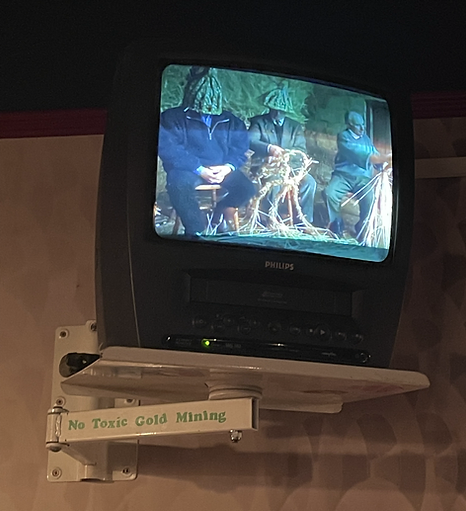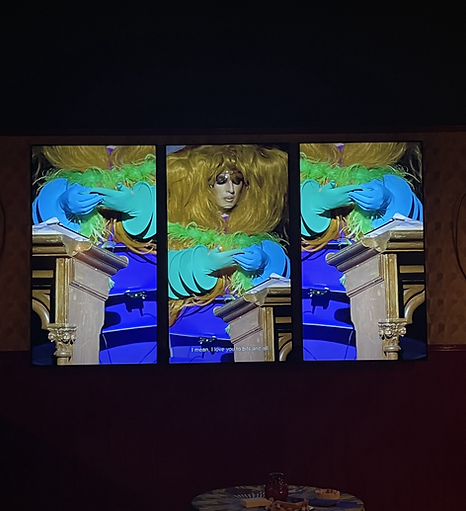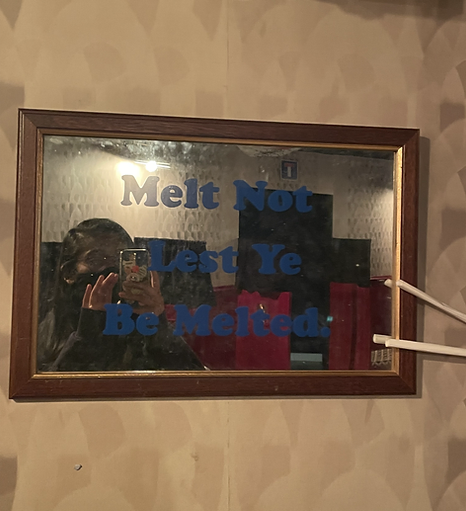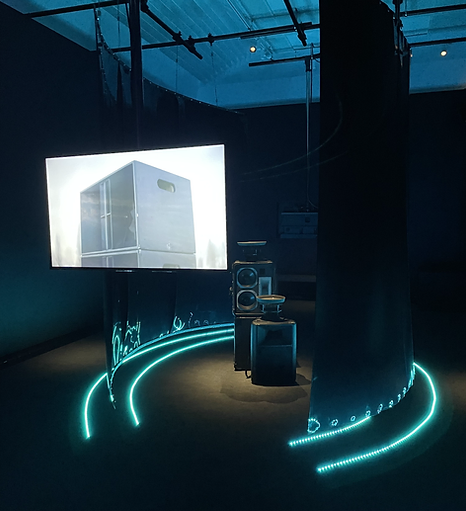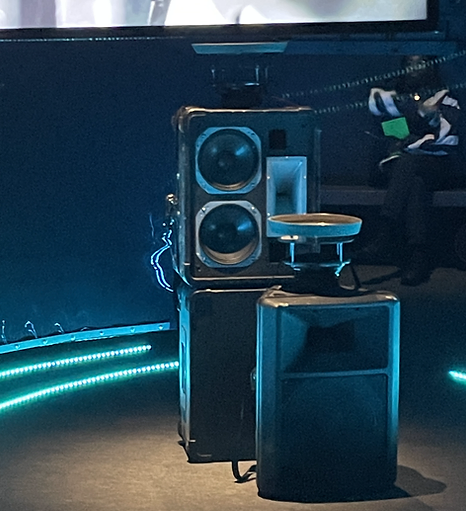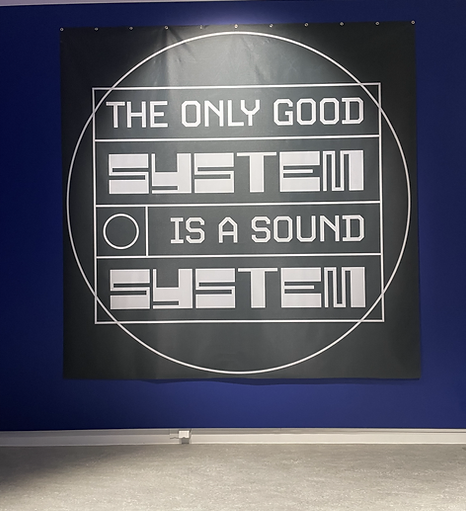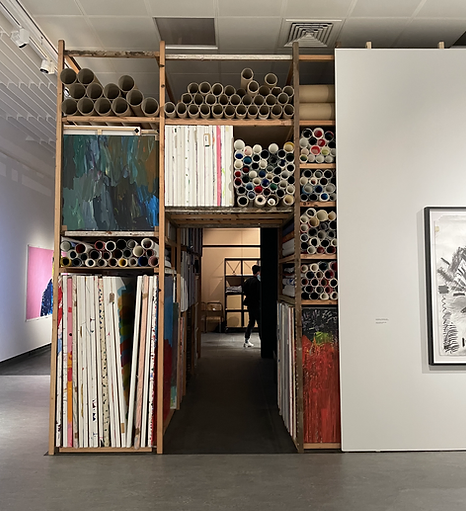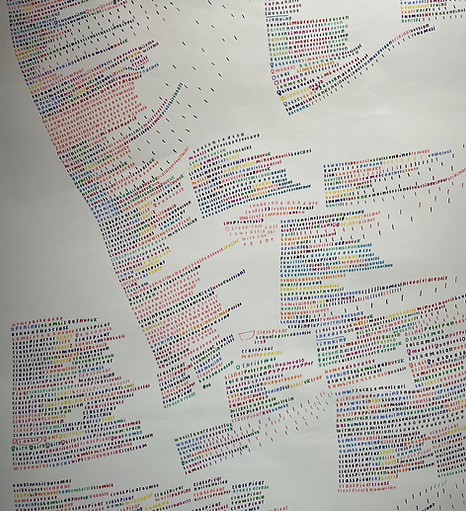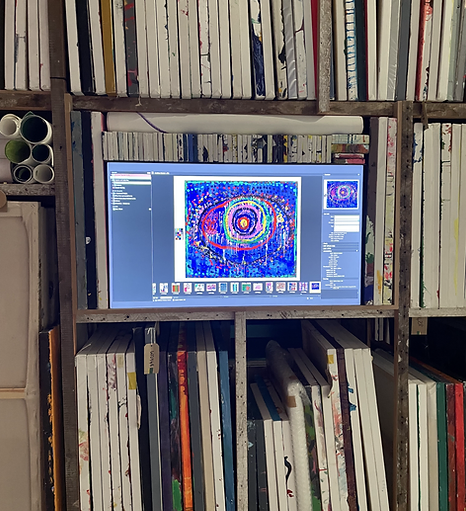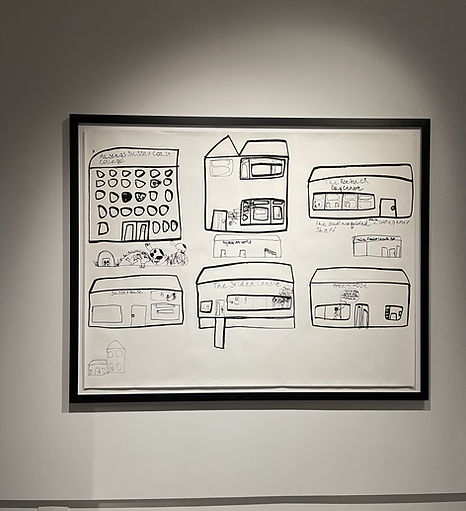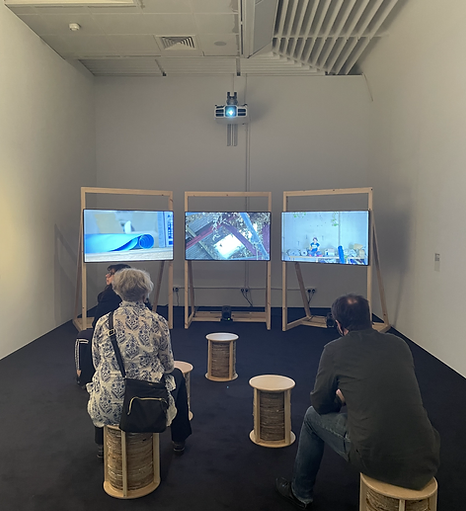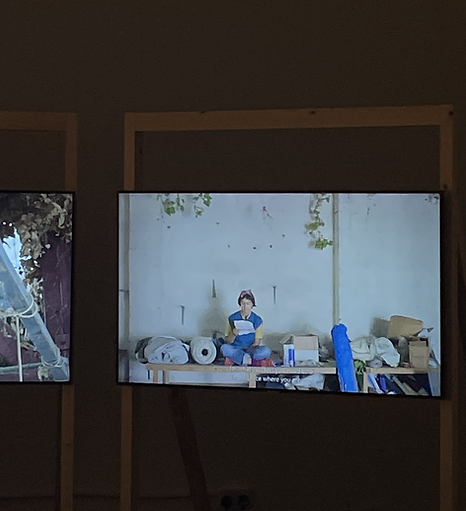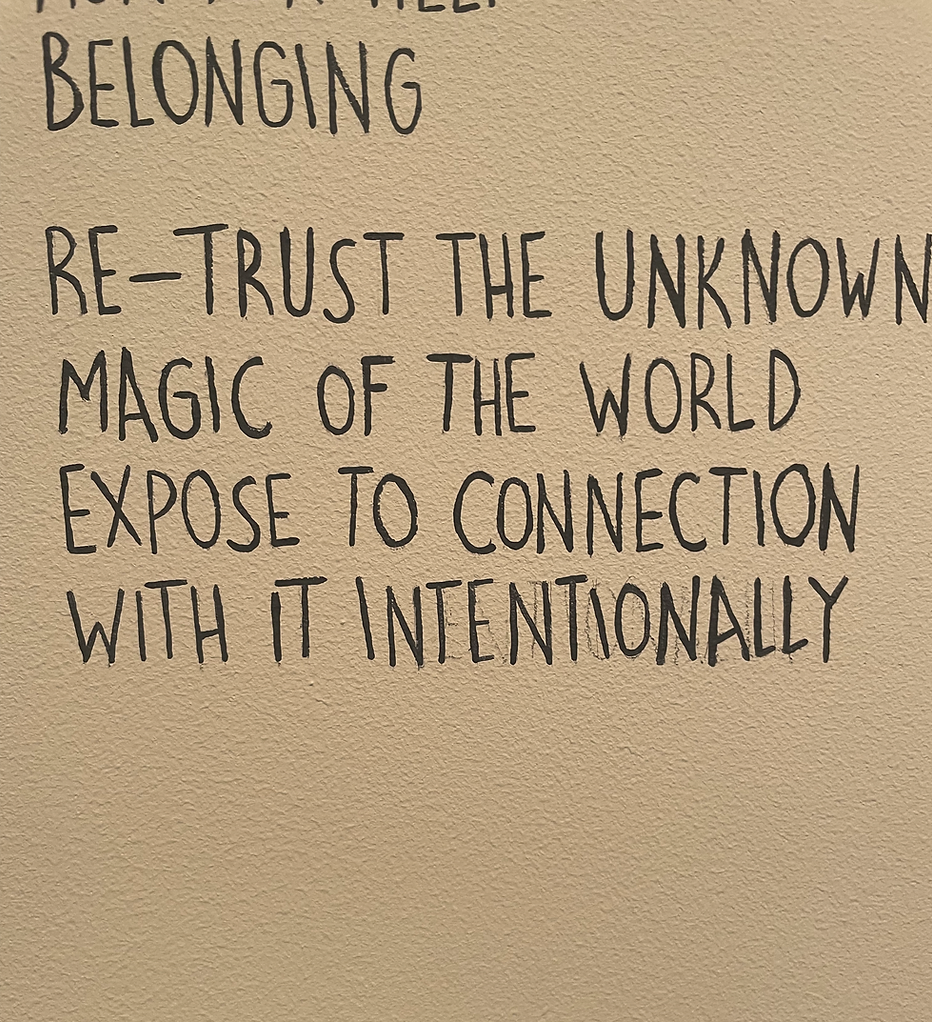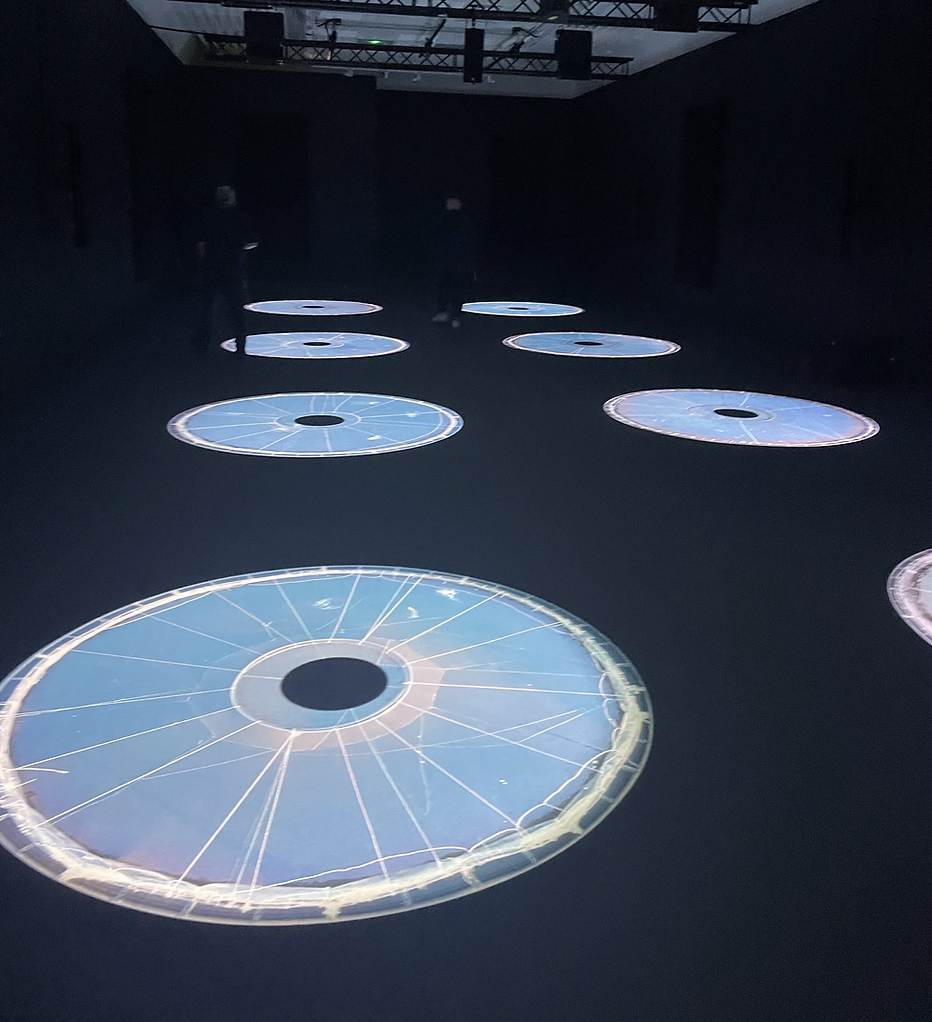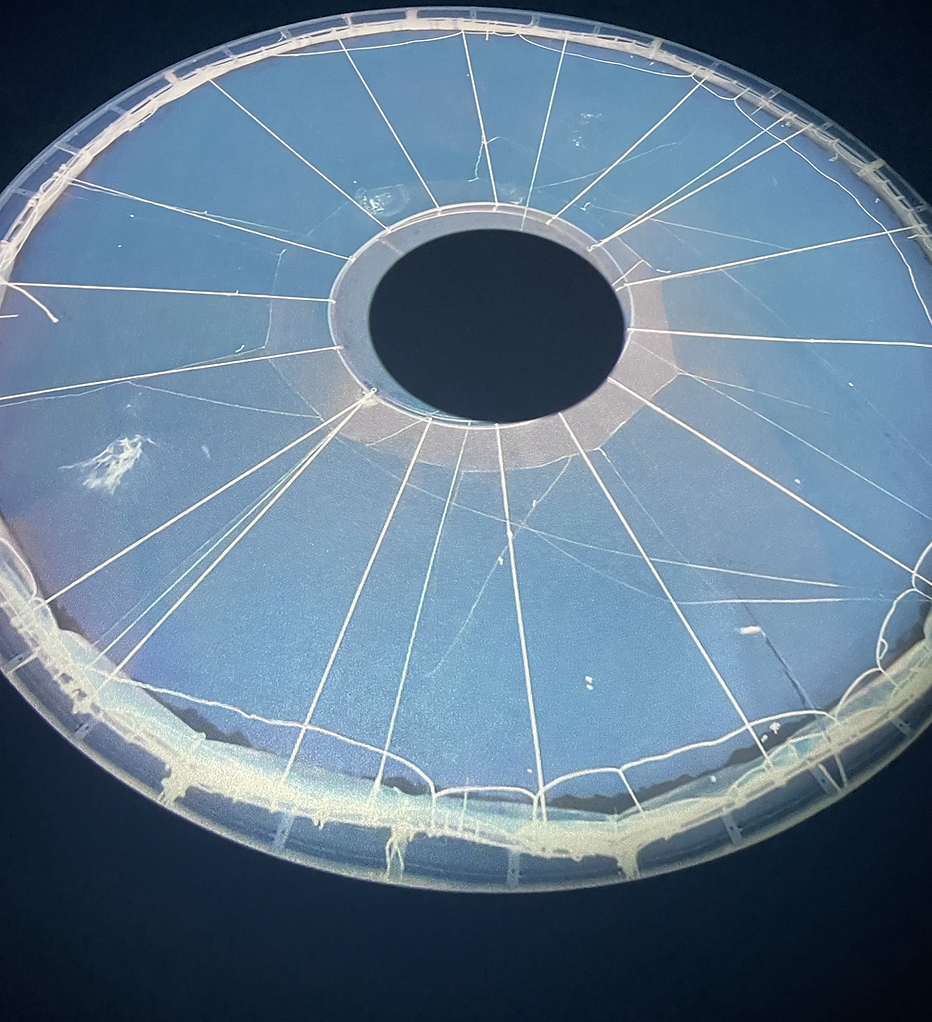Turner Prize 2021, Bumper Pack
Emoji summary: 🥵 🥰 🥶
For some reason, we’ve never reviewed the Turner Prize. I don’t know why because it has always gripped me. People either take it really seriously or are very (maybe rightly) cynical about it; but I honestly just can’t help but enjoy it. It feels like a rare moment where the art world is actually visible from the outside, taking on this glossy veneer, a bit of glamour. It has this encompassing grip from the inside too: everyone talks about it even if it’s only to complain. When I was a lil baby art student I thought it all looked so serious, but now I’m a Grown Up it just has guilty pleasure frivolous energy. Like those tiktoks about celebrity blind items, spilling all the gossip in a way that revolts you, but you can’t look away because it’s also fab and glittery in its unravelling. And maybe I mean that seriously, maybe I’m being sarcastic, maybe I JUST want to romanticise my life and be gossip girl for a weekend - I can’t tell. All I do know is: I went on a press trip to go have a peek at the Turner Prize before I went on holiday. I was bundled off the train with the rest of the press pack, onto a coach, straight to the Herbert Museum in Coventry. Now I want to take this deeply unglamorous experience, and give you something that goes a bit further than the basic arts journalism coverage n the think pieces. Maybe you want a guide rope round the show to bounce your thought n feelings off, maybe you just want someone to give you the round up so you don’t have to bother leaving ur house to go see it IRL. Whatever! Here’s a cheeky lil review, our bumper pack guide to the 2021 Turner Prize, xoxo Gossip Pube.
2021’s five nominees are all collectives, and for some people, this seems to be a lil novelty! But put a pin in the juicy bits, for now I’m going to introduce you to the nominees. Array Collective are a group of artists and activists, based in Belfast. Their work embraces a broad range: gender and reproductive rights, a strong mix of queer politic, anti-capitalist and just generally radical vibes. I think they’re cool, and I kinda wanna be friends. Black Obsidian Sound System is a collective based in London, that brings together queer trans and non binary poc and Black practitioners, working across art, sound and activism. The Sound System part of their name is real, BOSS is a fully functioning sound system, available to rent or use for community groups. It’ll become apparent further in, so I might as well declare my bias now: they’re my favourite of all the nominees, I have a lot of love and respect for their work, I cannot even pretend to hide it. Cooking Sections is a duo based in London, making work that uses food as an entry point, through which to access political objects. I have some thoughts about them. Gentle/Radical is a collaborative cultural project based in Riverside, Cardiff. As a collective, they have some pretty wide ranging skills: conflict resolution trainers, faith ministers, youth workers, land workers, as well as artists and writers. The press release says ‘Their aim is to rethink how we live with each other in more equitable ways’, which I find delightfully vague. Project Art Works is actually an NPO (National Portfolio Organisation) based in Hastings, they collaborate with artists who have complex support needs. Their work is bit more unwieldy and about infrastructure, but also about care and facilitation.
Those are the nominees! If this was the X factor: these are the ones that have made it past judges houses and we’re now onto the live finals. Now, lemme talk you through the work on display in the Herbert, in no particular order.
1: Array Collective are presenting a work called The Druithaib’s Ball; the official blurb says it’s a wake for the centenary of Ireland’s partition. You walk in to a darkened room, there are flagpoles all arranged in a circle, with a coloured spotlight shining across, casting long shadows. Walk past that to the structure; a síbín, a ~pub without permission~. It’s under a canopy of banners, most of them look like they’ve been yanked straight from a protest, but look closely: one of them reads LIVE LAUGH LOVE. Under this canopy, the síbín is a full theatrical set-up, complete with a bar, booths and ashtrays. On the wall, there’s a film playing. It flits across performances and performers, like they’re melting into each other. In one scene, a performer is dressed up as a moon boot (i think? That’s the impression I got). In another, a crowd is gathered along a street, they’re letting off smoke flares, and one person is dressed as a bumble bee. They march or they’re at that point in a protest when the speakers come on and are met with a roaring crowd. Someone is riding along the road on the top of a car covered in tinfoil. Someone is singing in a darkened bar, about robbing things from Tesco, about getting things in Asda over the border for £3 cheaper.
For me, this film is the main event, the rest is nice, but it’s just accessorising. Fluid, seamless, incredibly well done, but not in a super polished, too slick way. It’s well done in that it feels like a skilful hand has been turned to chaos. The whole room takes a jumble of things: queer aesthetics, performance, drag and activist aesthetics (and all the loaded meaning and weighty content that comes with them) as its main vocabulary, all in its true and messiest sense. The hand only forges a path, knowing when to peel back and when to grip firm. The resulting work is palpable and urgent; it made me want to scream, but in a good way. This is the kind of work I absolutely love, because chaos is something that, at its best, art is so good at handling. Array Collective do it beautifully, while producing an artwork that throws volume behind its political mouth.
2: Black Obsidian Sound System are occupying two spaces. Off to the side, there’s a corridor with purple strip lights, leading you into a dark room. There’s a split screen film playing on screens facing either end of the room. In the middle, a cluster of speakers loom like a body; still and contemplative. Flat, wide basins of water sit on top of the speakers, and with each hit of the bass, a ripple shocks out. Sometimes they’re even ripples, picture perfect like a desktop background. Sometimes the ripples are these jumping textured peaks, dimpling like thighs when you press into them with the soft of your finger. I spent more time watching the surface of the water: the way it was affected by sound, the way sound became physical. I thought about how two thirds of the human body is made of water, so what was happening to the water in me, in my heart and my muscle tissue and held inside by the thin limit of my skin’s lipid barrier. When I glanced back at the film, I think I saw a pair of trainers hanging from a phone line, twirling around in the wind - but I can’t be sure.
The space you walk into first is a workshop site, with banners hanging and a workbench set up. When I walked through, it was mostly empty, except for some beanbags and audio, and a lump of Black Obsidian on a plinth. The events and workshops hadn’t happened yet. But they’re going to host a live radio broadcast with a local community radio, Hillz FM. They’re also planning workshops to build Baby BOSS; two mini sound systems. One will stay in Coventry, and the other will go back to London with the collective. The official press release blurb says: the work in this room ‘makes the collective’s working practices and artistic labour visible’, but I’m not too sure about that. On the workbench there are two folders that contain instructions and budgets for assembling an actual sound system, the components that go into making a speaker or hooking up audio and wiring it all together. Maybe their labour is more visible, but I think it goes beyond just visibility and the heaviness that implies. I think it’s about open access, the way exchange can help circumvent the sticky politics of display. It’s also a generosity, on BOSS’s behalf as artists and practitioners: both sides, artist and local community or local audience, get something in this dynamic. There’s no give or take, no transaction, it’s levelled out. I think that’s a really clever way to handle being in an institution and machine as big as the Turner Prize; it is limber and practically literate, readjusts the scale and focus with precision and care.
3: At first glance, Project Art Works have a room that looks really traditional and Proper; like Proper Art. There are drawings and paintings hung up around the perimeter of the space; large scale and imposing, clean, there are little accordion books that fold out behind the glass wall of a vitrine. Then this proper-ness ruptures into something so much more unstable and interesting. The middle of the space is taken up by a huge block with open walled shelves; archive and storage for stack upon stack upon stack of paintings on stretched canvas, rolled up paper works, little boards. The works on the wall at the moment are just the surface, and this big storage set up has a heft. I walked up to a stack to peer round the edge of one canvas, the stack tipped open in the middle like a book. This storage isn’t just about hinting at all the other possibilities for arrangement, the heft of this archive is a point in and of itself. Like saying, ‘this is what’s possible: look at all this work that exists’.
This is pointed because of the unwieldy infrastructural role Project Art Works has as a nominee. I’ve gotta say, it is super interesting to have an NPO as a nominee, effectively acting as a broker, facilitator, or intermediary for a group of artists. The press release says, ‘[Project Art Works’] studios provide the conditions for a broad range of independent and collaborative practices with neurodivergent artists, who take part on their own terms to produce paintings, drawings, sculptural objects and film.’ That sentence is, unusually for a press release, doing a lot of work. We all know that the art world is inhospitable, conservative and predisposed to amplify the worst parts of society’s oppressive structures. Project Art Works’ role as an NPO and nominee might be unwieldy, but I’m not mad at it; it feels like a wider point about the way the art world is literally structured to make conditions incredibly difficult for neurodivergent artists, or artists with any kind of support or access needs. The hefty archive is made possible by quite simply providing conditions that allow for another way of doing things: in community, together. That’d be good for basically everyone.
At the far end of the space, there’s a full on studio. Artists will be working in the literal gallery space, making work and just inhabiting the room. I’m not sure what I think of that, or what that does to the space and the work on display, because press previews are awkward as fuck. They’re not ideal for having conversations with people, or asking questions, and I felt like we were a disruptive force sweeping through. I couldn’t catch the vibe of that studio set up without feeling like I was an interloper. That’s a gap in this review, I’ll have to leave it open for you to fill up yourself.
4: Gentle/Radical are presenting a work that is quite loose and sprawling. Heading into the space, there are a series of white banners along the corridor wall. The main part of the space is taken up by three screens, mounted on simple wooden frames. The work playing across is called Conversation Pieces, ten monologues spoken aloud by members of the collective. They are thick with emotion and thought, dense; family, ancestral ties, grief, loss, productivity and diaspora feels - at least, the one I watched was. The wall text said the duration was ‘variable’, which made me laugh, but I get the feeling I wasn’t meant to. The conversation is broken up by scenes from a workshop, community choirs and local residents sing together. They’re learning the Gorsedd Prayer: a Welsh prayer written in the 18th Century by a guy called Iolo Morganwg, who Wikipedia calls a ‘poet and collector of ill repute’ - which is very iconic. This prayer is an interesting choice, Morganwg was a kinda Romantic in the same way as William Blake and all those guys that lamented industrialisation. The press release calls it ‘a reimagining of a Welsh culture lost to colonialism’, which is a neat way to describe that very Victorian nostalgia for times past and lost. The image of the collective, choir and residents singing in chorus together is still powerful though, and moving. It was an acid hit, ripping through the slower pace of Conversation Pieces.
I can’t lie to you. I didn’t like the long film, and until the singing started, I was tetchy with this room. I understand: Gentle/Radical are doing slow, thoughtful work. This work is not about a polished outcome, but embracing open sprawling messiness in all its complexity. The art world does privilege finished objects, leaves little room for risk, innovation, it’s an environment where new forms are difficult to nurture. That means imagination is capped, development is stopped in its tracks, and you don’t have space to test things out just to see what happens. But I think even knowing that, I don’t know what this work was actually about. I have done my level best to describe it, but I am type type typing away and this is the best I can do. The subject was so vast, it contained everything, anything. Thought spilled out like liquid rushing over a floor. I wanted something to anchor it, properly. Maybe it’s just me? I might be looking for a muscularity that doesn’t always work, that is sometimes too brisk. I get that. It just reminded me of the way people sometimes talk, while trying to be thoughtful, but say nothing. You know when you think too hard, and get caught up in your own looping thought? I am too impatient. I’m sorry.
5: Cooking Sections have a dark room, lit by 8 blue circles projected onto the floor. Something moves within them, so I step closer to peer in; little fins and tails flap at the surface of a body of water. The 8 circles are arial shots of open-pen Salmon farms, fish ripple across the surface and the waves churn up against the edge of the container. There’s audio playing, and it’s not the exact same audio they presented at Tate Britain for the Art in Focus room, but it circulates the same kinda themes and handles it all in a similar way. ~Climavore~ etc: ‘a form of eating that adapts to the climate’. Salmon farms in Scotland, local ecosystems, drugs and excrement and synthetic colour leak out of these open pens into the wider water. I get it, and I’ve written about it before, so I’ll spare you. In summary, my words from the Tate Britain show still stand: ‘It feels like a powerful and compelling mix, and it makes me believe in art as a language and use of our collective time. Satisfying, yes yes yes, art is doing its Thing™️… Human Animal Colour Ecosystem. It hits me like those slow-mo Matrix action shots; boom, boom, boom.’
I feel resentful, like my enjoyment of the work is begrudging and against my will or better judgement. There’s a secondary aspect to the work in this room: Becoming CLIMAVORE involves institutions participating to remove farmed salmon from the menus in their restaurants and cafes. There’s a whole lil postcard set with QR codes, and a website that scrolls you through a list of the galleries and museums participating in this act of willing change; of introducing ~climavore alternatives~ as replacements.
Again, this is something I mentioned in my review of the Tate Britain show; I feel like a Bad Vibes Person, but this is annoying. Did everyone forget what happened last Summer? Institutions were posting black squares and evading legitimate critique by assembling racial equality task forces (note to self: they’re due a check up on those commitments they made), and making sweeping redundancies for front of house staff whose jobs were being outsourced to private companies, and moved on to zero hour contracts. Deep breath; I feel like I’m going mad. I feel like a Bad Vibes Person, because while I know that none of this is Cooking Sections’ fault or responsibility, I still feel a type of way about how easy it has been for them to implement the changes they want, across such a long list of institutions (21 by my count). I’m so happy for them, through my gritted teeth.
I do feel like we could all benefit from asking ourselves: why has this been accepted so willingly? What has facilitated this willingness for change on behalf of these institutions? Is it that Cooking Sections are basically just two white guy academics? Are they just using the right kinda cool thoughtful and academically rigorous language that allows institutions to flip this into systemic change as content for programming? Is this just a super institutionally palatable change, where the institutions aren’t structurally threatened by the demands being made? Because the villains aren’t the white middle class directors, but the Big Bad Salmon Farmers? Do white curators just care more about marine ecology and climate change than about people of colour? Why is this specific transformation acceptable or doable? There’s something in the Turner Prize booklet, the lil green one they handed out to us in the press pack, that just rubbed me the wrong way. In the Curator Notes for Cooking Sections, Alice O’Rourke (an Assistant Curator) writes: ‘Cooking Sections recognise that art alone cannot enforce this but see their practice as part of bringing about a cultural change… Transforming embedded habits and behaviours – from the individualistic to the systemic – requires ongoing and dedicated labour… we cannot challenge food systems without interrupting the status quo – from national art institutions through to restaurants, farms, supermarkets and homes.’ I AM SO GLAD you said that Alice, because you’re not wrong, but I feel like I’m in the twilight zone. I literally do not understand what makes this specific change manageable, what makes systemic change comprehensible when it’s about SALMON instead of PEOPLE. So if anyone would like to explain that to me, I am ready and listening and losing my mind.
So that’s the work! Now for the juicy bits. There’s a lot of fanfare this year, and everyone that was ~handling~ me had some great news they felt they had to urgently impart. This is the first year the Turner Prize has been to the Midlands! This is the first year the nominees have all been collectives! This is the most diverse nominee list! I have some thoughts.
The fuss that’s being made about the nominees all being collectives is a bit rich, and the nominees themselves have pointed this out. Back when the shortlist was announced, BOSS released a statement: ‘Whilst we are grateful for the recognition for our work as a collective, it is important for us to name some of the inconsistencies as we observe them… Although we believe collective organising is at the heart of transformation, it is evident that arts institutions, whilst enamoured by collective and social practices, are not properly equipped or resourced to deal with the realities that shape our lives and work. We see this in the lack of adequate financial remuneration for collectives in commissioning budgets and artist fees, and in the industry’s in-built reverence for individual inspiration over the diffusion, complexity and opacity of collaborative endeavour.’ It’s a salient point that brings us back to reality, undercutting the noise being made about this being a breakthrough year that recognises the role of collective working practices and the politic that comes with it. Institutions, especially institutions at the level of the Turner Prize and the Tate, are not equipped or resourced to handle these collectives within the space of their everyday programming streams. They might be enamoured with collectivity as edgy programming content or curatorial challenge, but they are not able to contribute to supporting it meaningfully, in the same way they’re able to support individual practitioners.
This is something that I don’t think the organisers are able to actually comprehend. Alex Farquharson, the Director of Tate Britain, writes in his foreword to the Turner Prize catalogue, ‘[the nominees’] collaborative practices reflect the solidarity and sense of community demonstrated across the UK in response to the pandemic.’ And it just made me laugh, literally, out loud. Because - yes, but! That pandemic solidarity and sense of community was coming from practitioners themselves, with no help from institutions. In fact, institutional contribution to the arts community in the pandemic amounted to endless obstacles and active damage. It was LITERALLY the LITERAL TATE making sweeping redundancies for front of house staff - many front of house roles are occupied by artists and aspiring art workers, looking to get a foothold in the industry, or as a day job to make ends meet, because artists don’t get paid enough to live off making art. The casualisation of front of house roles, at the Tate, and every other institution in the country tbh, now means that a source of stable employment has been pulled away for a huge chunk of the sector. It was also institutions that received a disproportionate share of cultural sector bail out money, while artists were largely hung out to dry; government funding for COVID recovery was directed to institutions as a distribution mechanism, but we know that they prioritise certain ways of working, and practitioners from certain ~contexts~. Institutions, on the whole, took the government’s money with one hand, and stuck its middle finger up at the rest of us with the other. So, I really do feel like with that particular sentence, Alex Farquharson is either the stupidest person in the world, or he’s being obtuse on purpose. Maybe he’s just being sarcastic - which I would actually respect!
But to return to BOSS’s point, it really readjusts that noise, and makes it all feel a bit hollow and spooky. I think it should rightly affect the way we talk about the nominees, and the way they sit against the wider institutional framework of the art world. Rather than this being a big positive moment for the Turner Prize in affirming radical working practices as institutionally legitimate, this should be a moment of stark recognition, that the art world owes these groups and others far more than they are currently giving.
It feels like part of the conversation I want to have, around the way this year’s nominees are proof of a wider lack in our arts landscape. Alongside BOSS’s point, there’s the point about Project Art Works; the unwieldiness of an NPO as a nominee, for the radical work of literally just facilitating conditions that allow neurodivergent artists the time space and means to make work. This is something Juliet Jacques pointed out, in an article for Frieze back in May, about what this year’s Turner Prize tells us about the arts after a decade of austerity. Juliet points out that the expanding popularity of collective working practices in the arts, and the increasing demand to democratise ‘the art world and its awards’, has happened against the backdrop of ‘the financial crisis of 2008 and the subsequent ruling-class turn towards austerity… This turn to the collective is not so much a rejection of the concept of ‘the artist’ as a response to a decade of funding cuts that have hit working-class and marginalised people the hardest.’ This collective turn has a political context, and the two things are interlinked; it’s part of the way the arts are instrumentalised to deliver welfare work and ‘fill gaps in service provision’ - something Morgan Quaintance writes about at greater length in his e-flux essay, Teleology & the Turner Prize. Juliet continues: 'Members of such collectives may be better equipped than individuals to work with communities on socially engaged projects, but they cannot perform the functions of the state forever.’ The way artists are deployed in this dynamic is something BOSS also pointed out in their statement, saying: ‘The urgency with which we have been asked to participate, perform and deliver demonstrates the extractive and exploitative practices in prize culture, and more widely across the industry – one where Black, brown, working class, disabled, queer bodies are desirable, quickly dispensable, but never sustainably cared for… We understand that we are being instrumentalised in this moment.’
In his essay, Pocket Utopias, the Turner Prize’s Lead Curator, Hammad Nasar introduces the curatorial themes of the exhibition, writing: ‘Art’s relationship to wider society is central to the practices of the five artist groups nominated… These artists share a belief in art’s capacity to replenish our reservoirs of hope. They are not content to notice things in the world and to point them out to the rest of us through works that live inside museums and galleries. They are, instead, engaged in constructing ‘pocket utopias’ – exercises in the real world that deploy the artistic imagination to propose new, more equal, more hopeful futures.’ In that essay, Hammad snitches on institutions, by way of not mentioning their role (or lack of active participation) in the construction and existence of these same pocket utopias. If artists reach beyond the gallery or museum, into the real world, what does that tell us about the position of those galleries and museums? This is the shape of it all: artists themselves are providing a response to the repeated attacks on every front from consecutive Conservative governments. Institutions are still rumbling along, replicating social inequalities, amplifying oppressive structures, and actively enabling state interests along the way. There’s a lack, a gap, a void! And it demands a response beyond attempts at co-option, or the token gesture of a nod in recognition. It deserves action in the form of lasting change, and it is no longer enough for curators and directors to leave the hard graft up to artists and practitioners alone. Art has a relationship to wider society, yeah? So what are art institutions doing to facilitate, maintain or contribute to that relationship?
I want to stress the need for this all to make an impact because it feels wrong that after all that we’ve been through, this year could pass like any other on to the next year and the year after, that institutions will have given their nod to collectives, but no more. I think this year’s nominees should be granted a series of wishes, like a legacy to implement in sweeping terms across the art world and its institutions. Maybe they would wish for better implementation of curatorial duties of care, so that art could be made in community by more people, stable and possible and beloved. Maybe they’d wish for budgets that were written better, with more space for multiple people’s fees, travel and accommodation, all already set out before they send the invitations and ask people to split things (like we know about all too well). Maybe they would wish for the Turner Prize to be more infrastructurally similar to the X Factor, with different groups that sit under the care of different judges: over 25s, groups accounted for consistently and catered to specifically, rather than just a flash in the pan as one year’s novelty. Maybe they would wish for a Turner Prize: groups spin-off, the same but for collective practices ONLY. Maybe they would wish for change a bit sooner along in the arts pipeline, and ask art schools to make collaborations easier, allowing students to collaborate and be marked together (which is rare atm, and has to be negotiated upfront - it defeats the purpose by asking for collaborative practices that already exist). There are five nominees, so we could have all of those. They could be rolled out like those Cooking Sections menu changes, everyone keen to get on board and make the transformation together.

